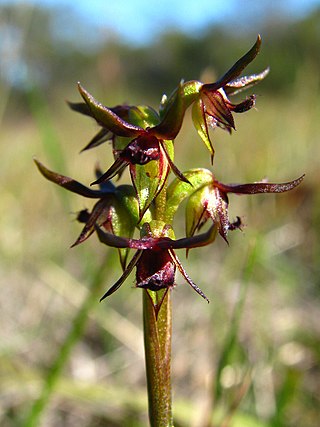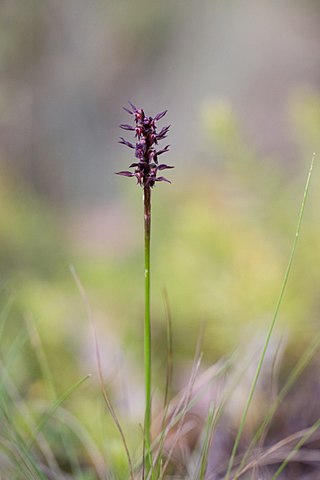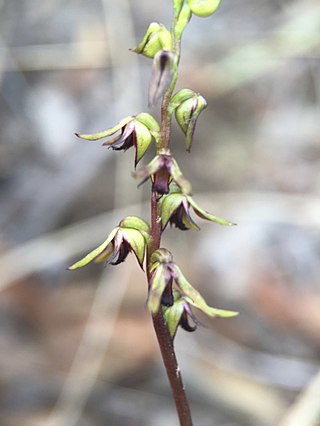Genoplesium rufum, commonly known as the rufous midge-orchid, is a species of orchid endemic to New South Wales. It has a single thin, wiry leaf and up to twenty five drooping, pinkish or reddish flowers on a flowering stem which is fused to the lower part of the leaf. It was formerly thought to range from Queensland to South Australia and Tasmania but specimens in other states are now assigned to Genoplesium clivicola.

Genoplesium nudiscapum, commonly known as the bare midge orchid, is a species of small terrestrial orchid endemic to Tasmania. It has a single thin leaf fused to the flowering stem and up to twenty small, green and reddish-brown flowers. It was thought to be extinct, since it had not been seen since 1852 but was rediscovered in 2008. The species has also been described as occurring on continental Australia. The species is known as Corunastylis nudiscapa in Tasmania.

Genoplesium filiforme, commonly known as the glandular midge orchid, is a small terrestrial orchid endemic to the east coast of Australia. It has a single thin leaf and up to thirty greenish to purple flowers with a reddish-purple labellum. The edges of its flower parts are covered with many short glandular hairs. It is found from southern Queensland to southern New South Wales.

Genoplesium morrisii, commonly known as the bearded midge orchid and known as Corunastylis morrisii in Australia, is a small terrestrial orchid endemic to south-eastern Australia. It has a single thin leaf fused to the flowering stem and up to fifteen small, dark purplish-black or green and purple flowers.

Genoplesium archeri, commonly known as the elfin midge orchid and as Corunastylis archeri in Australia, is a small terrestrial orchid endemic to south-eastern Australia. It has a single thin leaf fused to the flowering stem and up to fifteen small, hairy, yellowish green flowers with purple stripes. It grows in a wide range of habitats in New South Wales, Victoria and Tasmania.

Genoplesium arrectum, commonly known as the erect midge orchid and as Corunastylis arrecta in Australia, is a small terrestrial orchid endemic to south-eastern Australia. It has a single thin leaf fused to the flowering stem and up to twenty small, dark purple flowers. It grows in a montane and subalpine grassland and forest in Victoria and the Australian Capital Territory.
Genoplesium capparinum, is a small terrestrial orchid endemic to Victoria. It is one of the midge orchids and has a single thin leaf fused to the flowering stem and up to twenty small, green flowers with purple markings. It is a rare species, found only in a small area in the south-east of the state.

Genoplesium clivicola is species of small terrestrial orchid that is endemic to south-eastern Australia. It has a single thin leaf fused to the flowering stem and up to twenty five small, greenish and reddish flowers. It grows in forest and woodland in Victoria, the Australian Capital Territory and New South Wales.
Genoplesium cranei, commonly known as the Blackall Range midge orchid, is a small terrestrial orchid endemic to the Blackall Range in Queensland. It has a single thin leaf fused to the flowering stem and up to twenty small, green to greenish yellow flowers with reddish markings. It grows in open forest with shrubs and grasses.
Genoplesium pedersonii, commonly known as Pederson's midge orchid, is a species of small terrestrial orchid endemic to the Blackdown Tableland in Queensland. It has a single thin leaf fused to the flowering stem and up to thirty small, greenish red to reddish, self-pollinating flowers with a dark purplish red labellum. The species is treated as Corunastylis pedersonii in Queensland.

Genoplesium pumilum, commonly known as the green midge orchid in Australia, and the yellow gumland leek orchid in New Zealand is a small terrestrial orchid native to south-eastern Australia and New Zealand. It has a single thin leaf fused to the flowering stem and up to twenty five green to yellowish-green flowers which sometimes have red markings. Australian and New Zealand authorities use the name Corunastylis pumila.
Genoplesium sagittiferum, commonly known as the horned midge orchid, is a species of small terrestrial orchid that is endemic to New South Wales. It has a single thin leaf fused to the flowering stem and up to ten small, yellowish-green flowers with a hairy reddish labellum.
Genoplesium sigmoideum, commonly known as the Dave's Creek midge orchid, is a species of small terrestrial orchid that is endemic to a small area in the Lamington National Park in Queensland. It has a single thin leaf fused to the flowering stem and up to twenty dark red flowers with a hairy labellum. The species is treated as Corunastylis sigmoidea in Queensland.
Genoplesium superbum, commonly known as the pink midge orchid or superb midge orchid, is a species of small terrestrial orchid that is endemic to New South Wales. It has a single thin leaf and up to fifteen dark pinkish-purple flowers, which lean downwards. It is listed as "endangered" in New South Wales because of its limited distribution and disturbance of its habitat.
Genoplesium tectum, commonly known as the Cardwell midge orchid, is a small terrestrial orchid endemic to a small area in north-eastern Queensland. It has a single thin leaf fused to the flowering stem and up to thirty light red flowers with a dark reddish-black, hairy labellum.
Genoplesium turfosum, commonly known as the alpine midge orchid, is a small terrestrial orchid endemic to a small area in the higher parts of New South Wales. It has a single thin leaf fused to the flowering stem and up to twenty five dark purplish-red, crowded flowers with a sparsely hairy labellum.
Genoplesium leptochilum is a small terrestrial orchid endemic to Victoria. It has a single thin leaf fused to the flowering stem and up to twenty small reddish-brown to dark purplish flowers. It is known from one population with only six plants in forest near a swamp.
Genoplesium carectum is a species of small terrestrial orchid endemic to a restricted part of New South Wales. It has a single leaf fused to the flowering stem and between three and thirteen brownish-green flowers with purple and red markings. It occurs in three populations in swampy places in and near Wollemi National Park.
Genoplesium cuspidatum is a species of small terrestrial orchid endemic to eastern Australia. It has a single leaf fused to the flowering stem and between 6 and 28 reddish to dark purple flowers with prominent darker stripes.
Genoplesium tenellum is a species of small terrestrial orchid that is endemic to eastern Australia. It has a single leaf fused to the flowering stem and between 5 and 21 green flowers with reddish-purple lines and markings.






